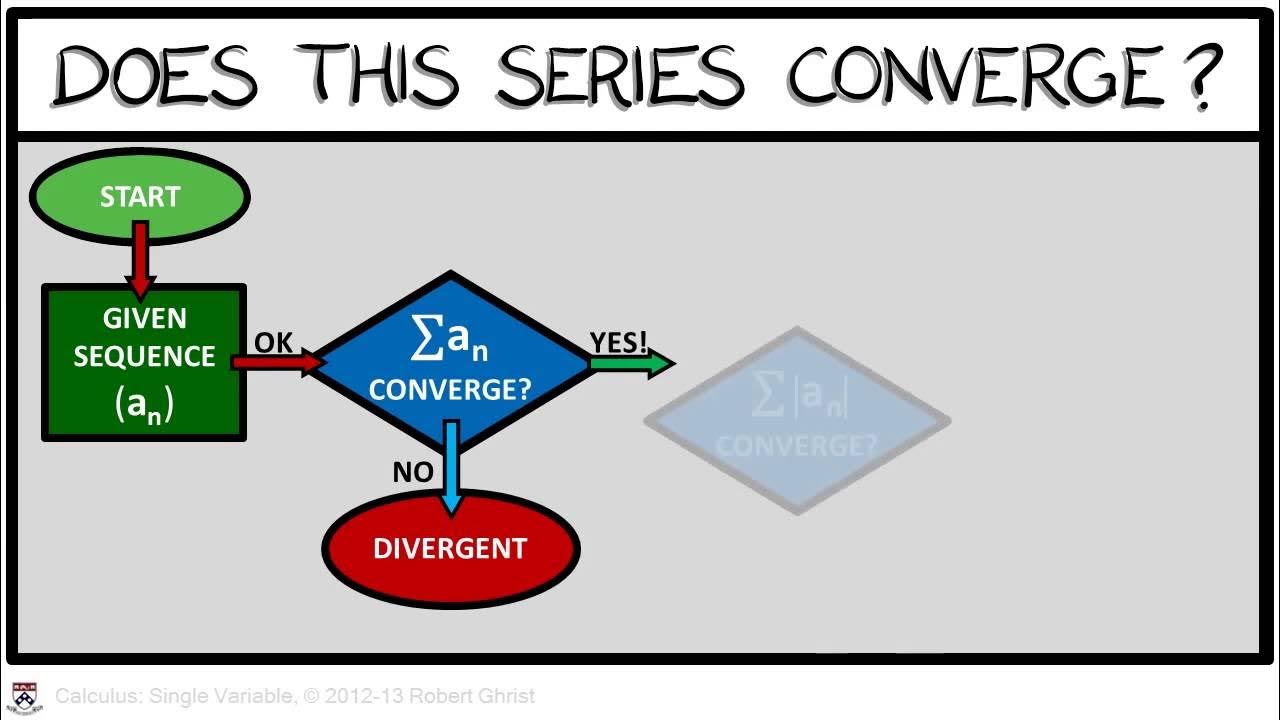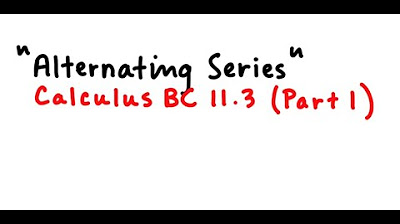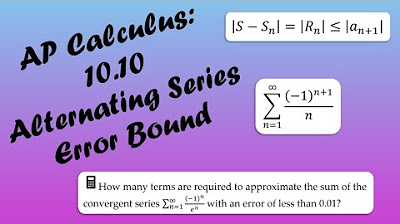The best A – A ≠ 0 paradox
TLDRThis Mathologer video explores the intriguing paradox of the alternating harmonic series, demonstrating how it sums to the natural logarithm of 2 despite terms cancelling out. The host visually illustrates this with 'rectangle snakes' and delves into the concept of conditional convergence, showing that with the right rearrangement, any target sum, including irrational numbers like pi, can be approached or achieved. The video concludes with a discussion on the Riemann rearrangement theorem, emphasizing the importance of term distribution in infinite series.
Takeaways
- 🔍 The video discusses the alternating harmonic series, an infinite series with reciprocal terms and alternating signs.
- 😮 It introduces a paradox where rearranging the terms of the series leads to a sum of zero, while the actual sum approaches the natural logarithm of 2 (ln(2)).
- 📚 The script explains the concept of conditionally convergent series, which can have their terms rearranged to yield different sums.
- 📉 The video uses a visual representation of the series with rectangles under a 1/x graph to demonstrate how the series' sum evolves.
- 🔄 It shows a method of 'squishing and stretching' the rectangles to fit perfectly along the 1/x curve, illustrating the sum's approach to ln(2).
- 🤔 The script raises the question of whether different distributions of positive and negative terms can result in other sums, such as pi (π).
- 📐 The video explores the idea of using 'rectangle snakes' to visualize and calculate the sums of different series patterns.
- 🧩 It presents a pattern where m positive terms followed by n negative terms can be summed to ln(m), and generalizes this for different m and n.
- 🎯 The script challenges the viewer to consider if it's possible to achieve any arbitrary sum, such as pi, through series rearrangement.
- 📖 The video touches on the Riemann rearrangement theorem, which formalizes the idea that conditionally convergent series can be rearranged to sum to any number.
- 🎶 The conclusion includes an animated demonstration of using 'weird snakes' to find exact sums for specific series patterns, accompanied by music.
Q & A
What is the alternating harmonic series mentioned in the video?
-The alternating harmonic series is an infinite series that starts with 1, then alternates between adding and subtracting the reciprocals of natural numbers: 1 - 1/2 + 1/3 - 1/4, and so on.
What paradox does the video discuss regarding the alternating harmonic series?
-The paradox is that even though every positive term in the series is eventually canceled out by a negative term, the series does not sum to zero. Instead, it sums to a specific positive number, the natural logarithm of 2.
How does the video demonstrate the cancellation of terms in the alternating harmonic series?
-The video shows that by rewriting each negative term with an even denominator as the difference of two fractions with that denominator, and then separating the positive and negative terms, every positive term is canceled out by a negative term.
What visual method does the video use to represent the terms of the series?
-The video uses rectangles with areas equal to the terms of the series (1/n) to visually represent the series. The rectangles are placed along the 1/x graph to demonstrate the sum of the series.
What is the significance of the number e^π in the video?
-The number e^π, also known as Gelfond's number, is mentioned as an example of a number that cannot be achieved as the sum of the series by simply changing the distribution of positive and negative terms, because it is known to be irrational.
How does the video explain the possibility of achieving any desired sum with the series?
-The video explains that by using an over-and-under-shooting algorithm, where terms are added or subtracted to overshoot or undershoot the target sum and then adjusted, it is possible to converge to any desired sum, including irrational numbers.
What is the Riemann rearrangement theorem mentioned in the video?
-The Riemann rearrangement theorem states that for any conditionally convergent series, it is possible to rearrange the terms to obtain any desired sum, even though the original series may have a different sum.
How does the video connect the distribution of positive and negative terms to the sum of the series?
-The video shows that by changing the distribution of positive and negative terms (e.g., m positive terms followed by n negative terms), the sum of the series can be different, and it can be expressed as a difference of two logarithms.
What is the role of the natural logarithm in the sums of the rearranged series?
-The natural logarithm appears as the sum of the series when the distribution of terms is such that m positive terms are followed by 1 negative term, resulting in a sum of ln(m).
How does the video use the concept of 'snakes' to visualize the sum of the series?
-The video uses the term 'snakes' to refer to the sequences of rectangles representing the terms of the series. By squishing and stretching these 'snakes' and fitting them into the 1/x graph, the video visually demonstrates how the sum of the series evolves.
Outlines
🔍 Introduction to the Alternating Harmonic Series Paradox
The script begins with an introduction to the famous alternating harmonic series, an infinite series where the reciprocals of natural numbers are summed with alternating signs. The video promises to reveal a beautiful visual resolution to a paradox associated with this series. The paradox involves rewriting negative terms with even denominators and showing that, seemingly, all terms cancel out, suggesting a sum of zero. However, the actual sum approaches a positive number, specifically the natural logarithm of 2, which is approximately 0.7, contradicting the initial assumption. The script teases a visual explanation for this phenomenon and hints at further exploration in the video.
📊 Visualizing the Series and the Logarithmic Sum
The script moves on to a visual representation of the series using rectangles and the 1/x graph, illustrating how the terms of the series can be visualized as areas under the curve. By adding terms sequentially and coloring the finite sums, a pattern emerges where the areas form 'snakes' of rectangles. The script explains how these snakes can be rearranged and scaled to fit perfectly along the 1/x curve, leading to the realization that the sum of the series is equal to the natural logarithm of 2. This section provides a step-by-step guide to visualizing the series and understanding the surprising result through geometric manipulation.
🔄 Exploring Series with Different Term Distributions
The script delves into the effects of changing the distribution of positive and negative terms in the series, such as having three positive terms followed by one negative term. It discusses the sums that result from these different distributions and poses the question of whether an arbitrary number like Pi can be achieved as the sum of such a series. The video promises to answer these questions in the second part, using the metaphor of 'rectangle snake charming' to describe the process of visualizing and understanding these sums.
🧩 The Riemann Rearrangement Theorem and Series Sums
This section introduces the Riemann rearrangement theorem, which states that the sum of an infinite series can change based on the order of its terms, a concept counterintuitive to finite sums. The script explains that the alternating harmonic series is conditionally convergent, meaning it can be rearranged to yield any sum. It also touches on the impossibility of achieving certain sums, like Pi, through simple distributions of terms, and introduces the concept of using more complex series to approximate or achieve any desired sum.
🎯 Achieving Any Desired Sum Through Series Rearrangement
The script concludes with a discussion on the ability to achieve any desired sum through the rearrangement of an infinite series, using the example of Pi. It explains that while simple distributions of terms cannot sum to Pi, the series can be manipulated to get arbitrarily close to it. The video also highlights the generalizability of this approach to any target number and introduces the concept of conditionally convergent series, which can be rearranged to yield any sum due to the properties of their positive and negative parts.
🎶 Final Thoughts and Animation on Series Sums
In the final paragraph, the script hints at additional insights gained through further exploration of the series, including the use of 'weird snakes' to determine exact sums of different series rearrangements. It promises to end the video with an animation and music, providing a creative and engaging conclusion to the discussion on series sums. The script also mentions the importance of understanding the properties of series to determine whether they can be rearranged to achieve different sums.
Mindmap
Keywords
💡Alternating Harmonic Series
💡Paradox
💡Natural Logarithm
💡Infinite Series
💡Visual Representation
💡Riemann Rearrangement Theorem
💡Conditionally Convergent
💡AHA Moments
💡Rectangle Snake
💡Gelfond’s Number
Highlights
Introduction of the alternating harmonic series and its visual paradox.
Rewriting negative even denominator terms to reveal a pattern.
Surprising cancellation of terms leading to an unexpected sum of 0.
Discovery that finite sums approach the natural logarithm of 2, not 0.
Explanation of the paradox through the imbalance of positive and negative terms.
Visual representation of the series using the 1/x graph.
Innovative method of visualizing the series by squishing and stretching rectangles.
Demonstration that the orange area under the curve equals the natural logarithm of 2.
Exploration of different distributions of positive and negative terms.
Introduction of the concept of conditionally convergent series.
The possibility of arranging terms to achieve any desired sum.
The connection between series sums and the natural logarithm of integers.
Challenge of achieving a sum of Pi through series rearrangement.
Explanation of Gelfond's number and its relation to the irrationality of e^π.
Approximation of Pi using series sums and the significance of Gelfond's number.
Generalization of the series sum pattern for any positive integers m and n.
The Riemann rearrangement theorem and its implications for infinite series.
Demonstration of achieving any target number using the over-and-under-shooting algorithm.
The limitations of achieving exact sums like Pi and the use of approximations.
Final thoughts on the power of series manipulation and its mathematical implications.
Transcripts
5.0 / 5 (0 votes)
Thanks for rating:





